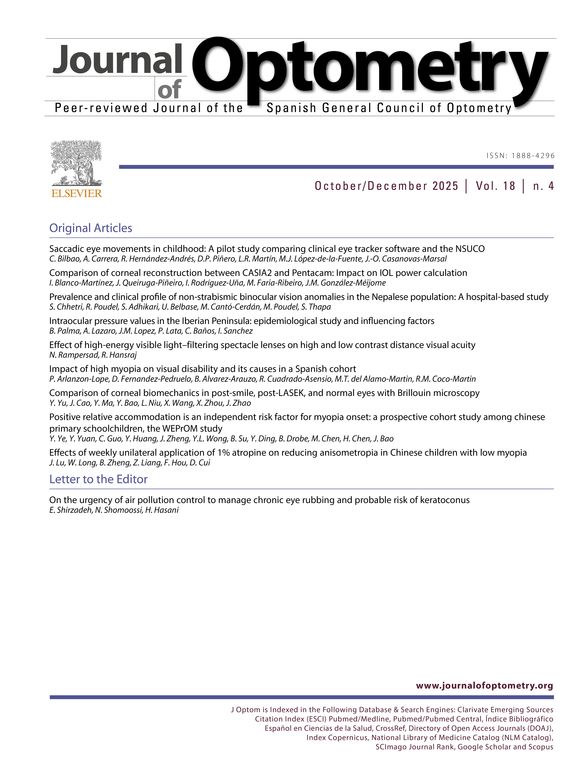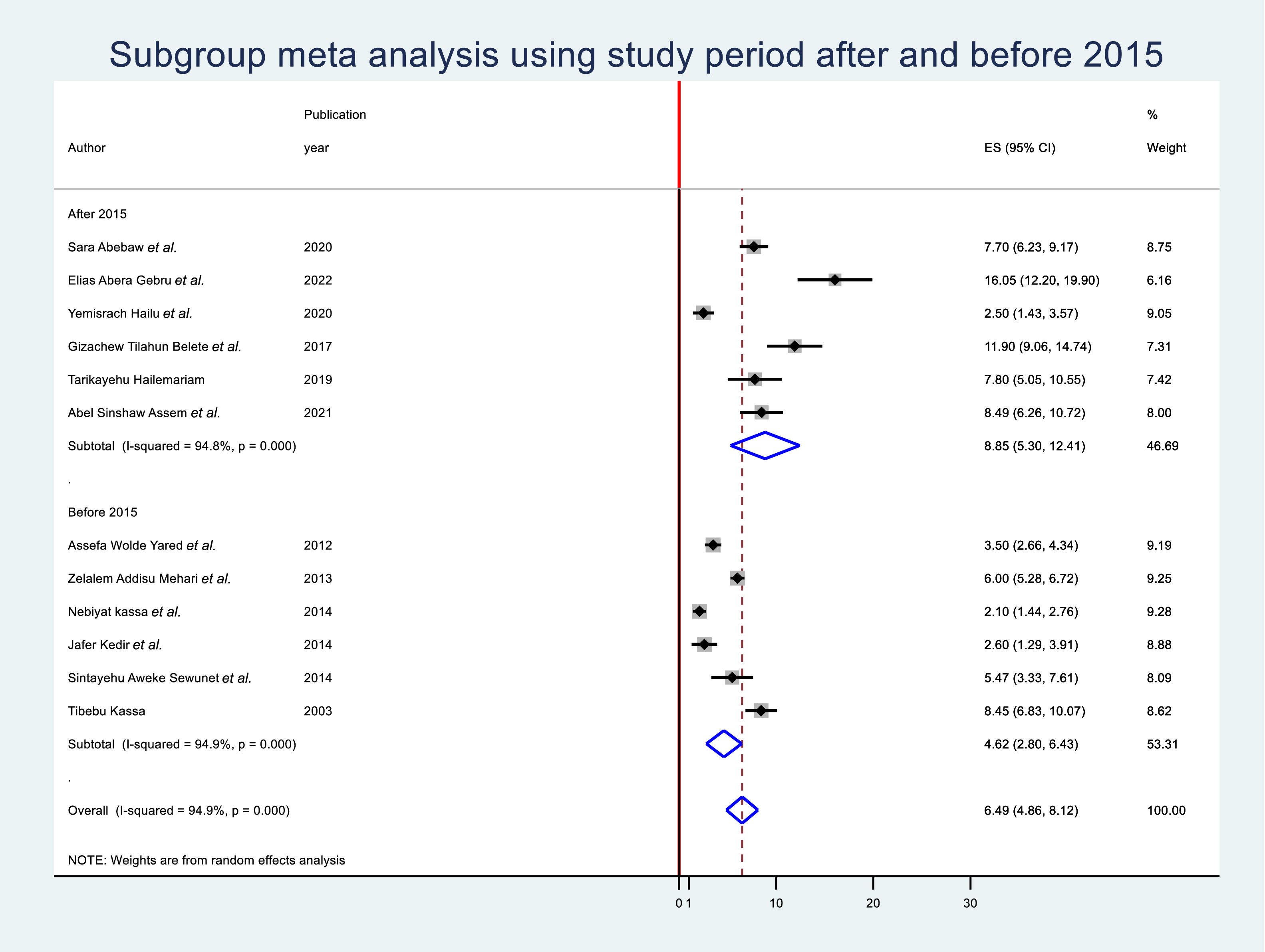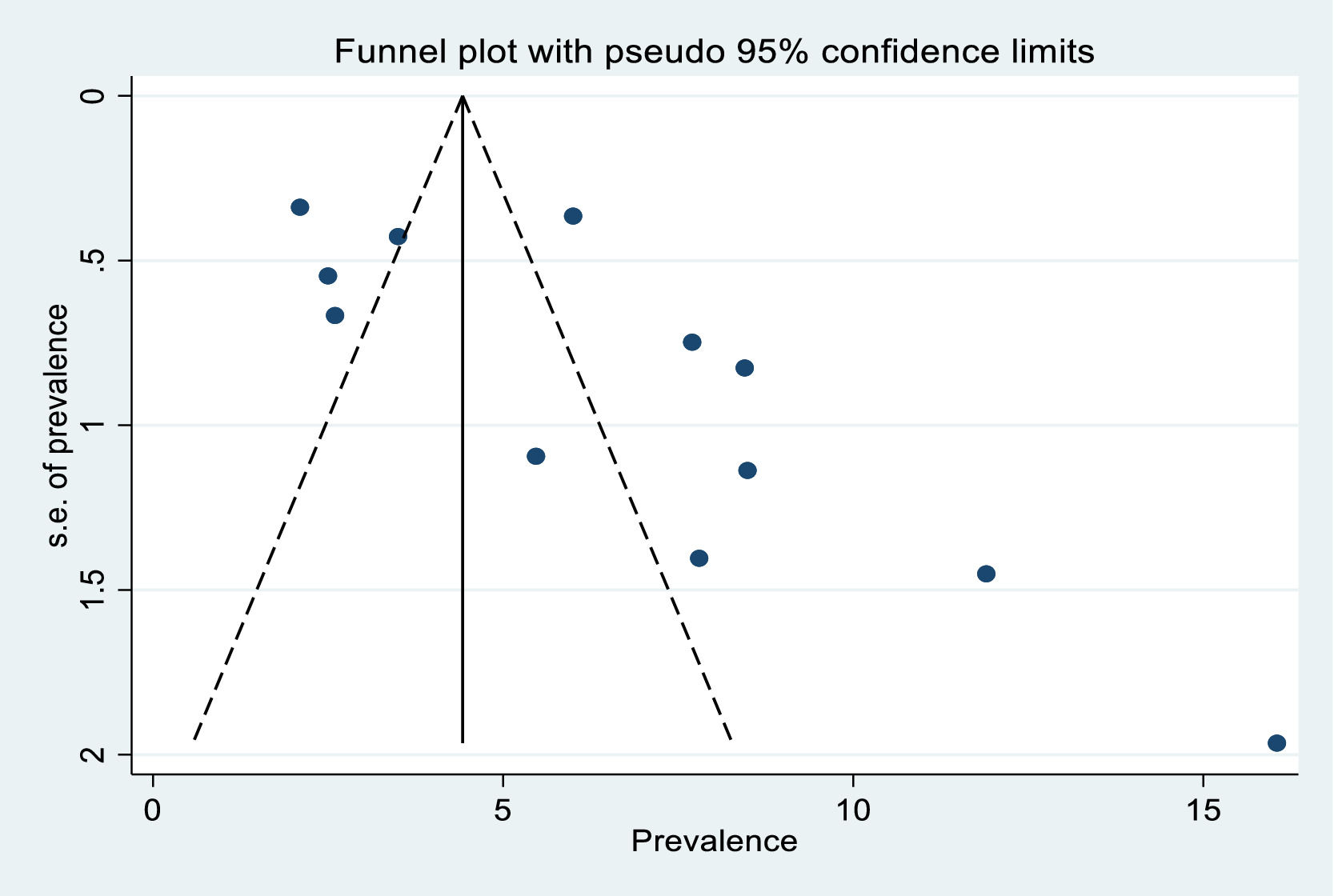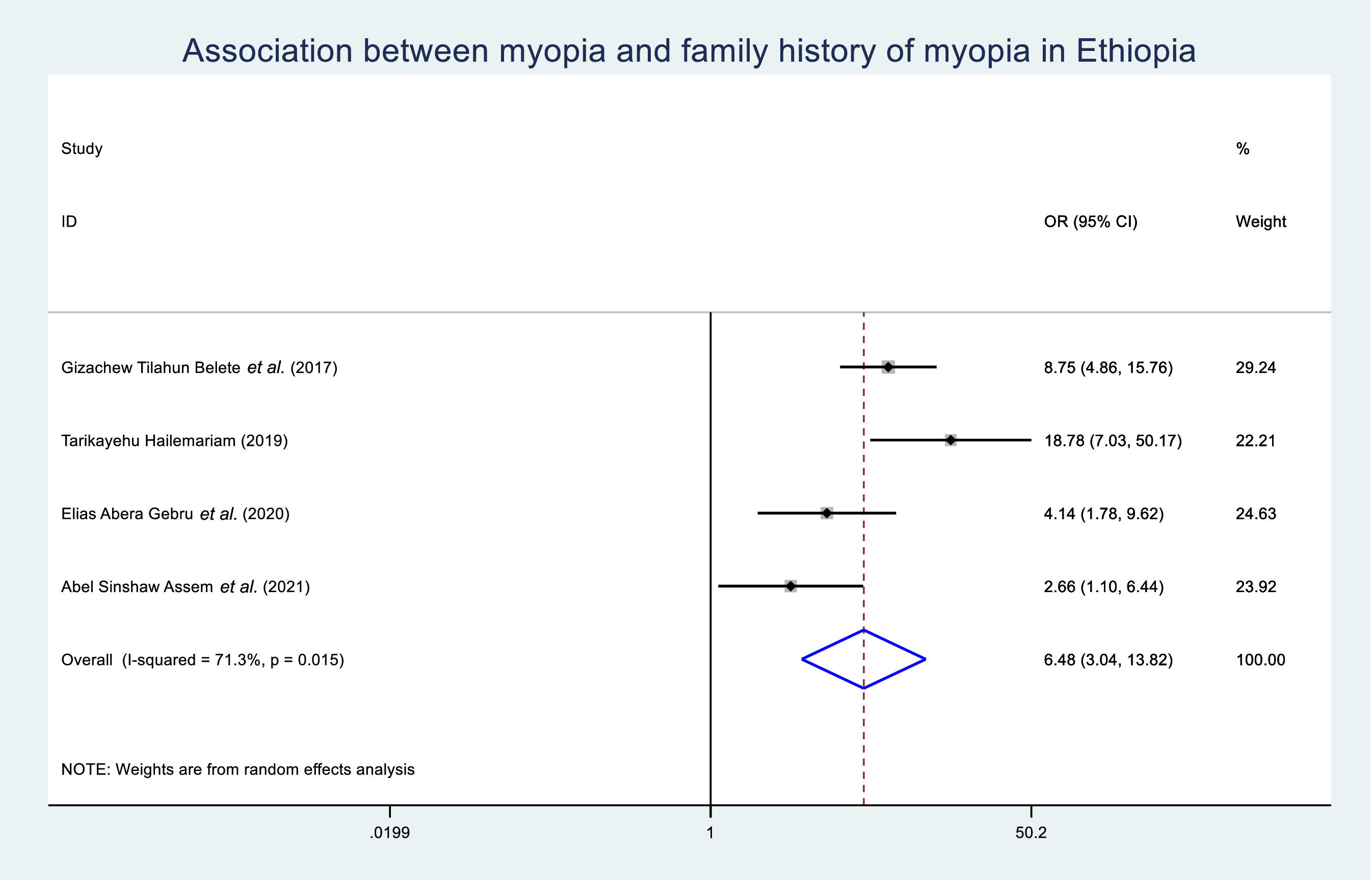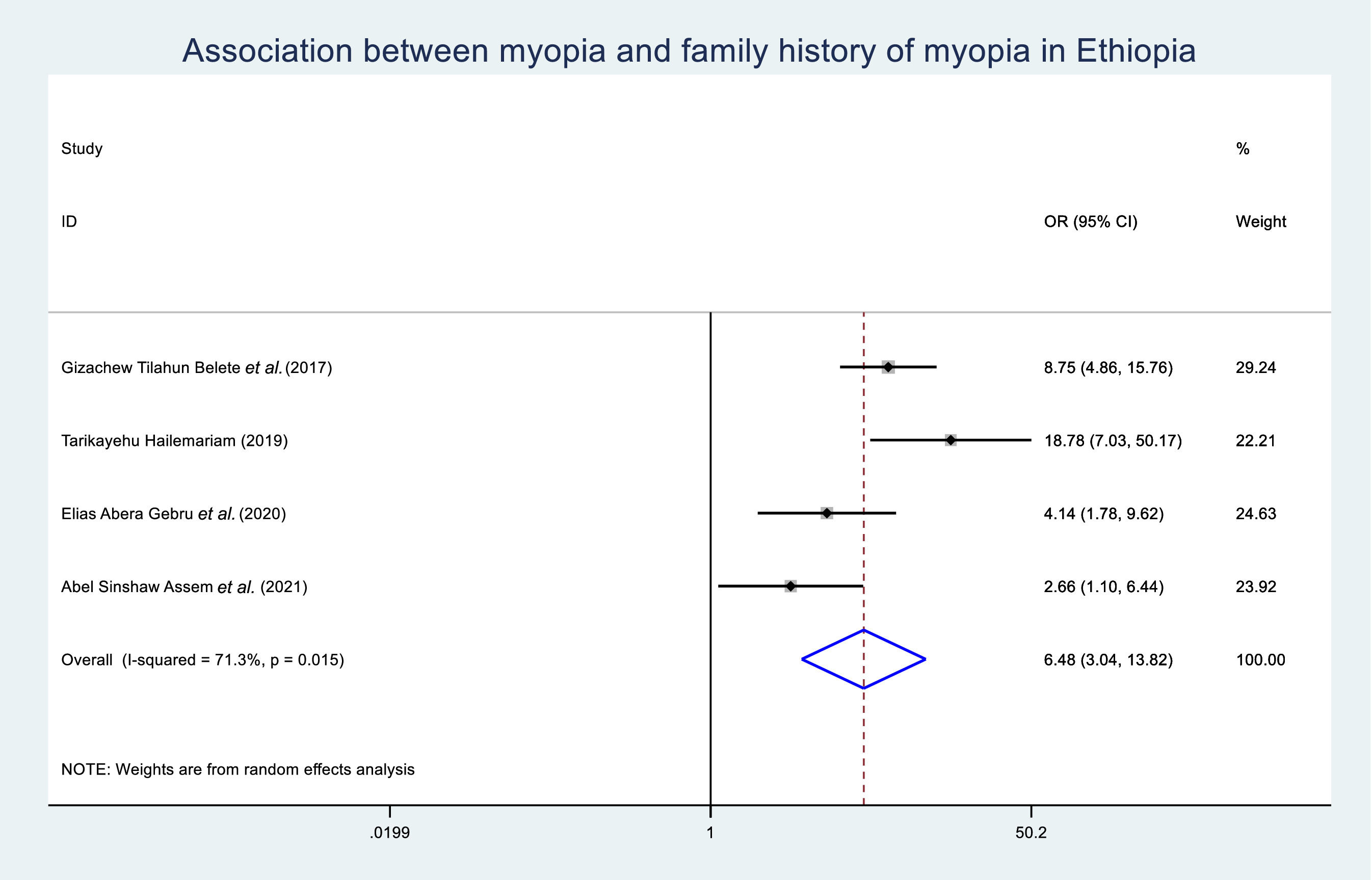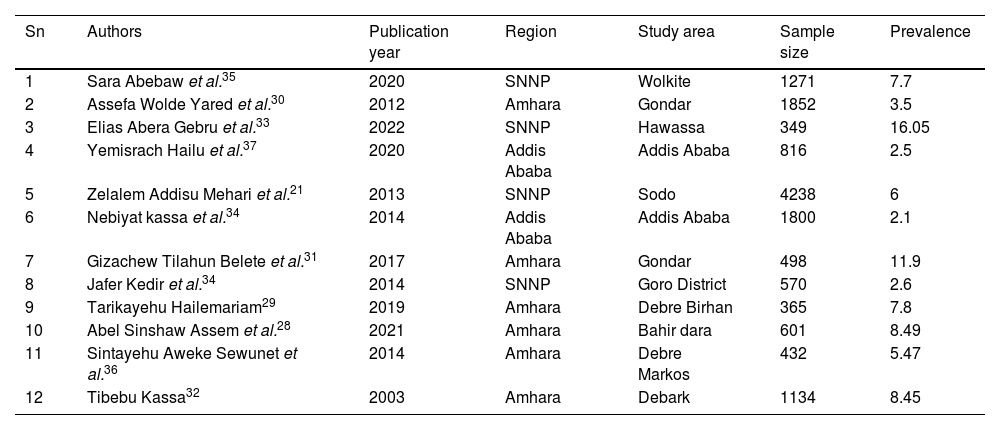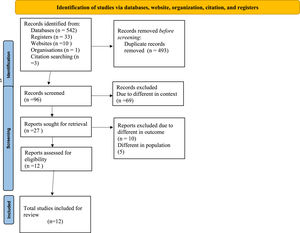Myopia is a global public health concern that has a significant socioeconomic and psychological impact on schoolchildren. If Myopic patients are not detected early, they are exposed to retinal detachment, cataracts, and glaucoma. There have been previous studies conducted in Ethiopia, but there is significant inconsistency among studies. Hence, the aim of this study was to provide a single figure as well as associated factors for Myopia among Ethiopian schoolchildren.
MethodThe national and international databases and gray literature were searched for important research articles. This review included school-based cross-sectional studies that were reported in English. The data were extracted using Microsoft word and exported to Stata™ Version 17.0 statistical software for further management and analysis .The presence of heterogeneity was checked using Cochrane Q test via fixed effects model and presented by forest plots with 95% CI. Due to the presence of substantial heterogeneity, I2 test using random effects model was computed to estimate the effect size. The existing heterogeneity among studies was explained by regional difference. To identify factors associated with myopia, meta regression was computed and significant factors was reported using OR with 95% CI.
ResultsIn this systematic review and meta-analysis, 12 studies with a total of 9688 schoolchildren were included. The national estimate of myopia among schoolchildren in Ethiopia was 6.49% (95%CI: 4.86, 8.12). Having family history of myopia (OR: 9.18, 95%CI: 3.5,24.02) and being female (OR: 0.94, 95% CI: 0.50, 0.98) were the identified factors associated with myopia.
ConclusionMyopia is one of the most prevalent childhood health condition in Ethiopia, which affects about one in every fourteen schoolchildren. Schoolchildren who had family history of myopia and being female were the identified risk factors of myopia among schoolchildren. Clinical and public engagement activities are needed to address the burden of myopia.
Myopia is a visual impairment (refractive error) when accommodation is relaxed, parallel light rays from an object at infinity focus in front of the retina.1 Because unaided near visual acuity of the myopic eye is usually normal or better than unaided distance acuity (blurry vision), it is commonly referred to as “nearsightedness.” 2 Nearsighted people are more likely to develop vision-threatening conditions such as retinal detachment, choroidal atrophy, cataracts, and glaucoma.3 Bifocal spectacles, cycloplegic drops, intraocular pressure-lowering drugs, muscarinic receptor antagonists, and contact lenses have all been investigated as interventions to slow the progression of myopia.4 Almost all patients with myopia can have good vision if they receive early and appropriate correction.5,6 The burdens of uncorrected myopia are serious especially in students. Poor vision and an inability to read material on the chalkboard due to myopia can greatly affect a student's participation in education, different activities, and other social participations. Furthermore, when they become adults they are excluded from productive working lives, which results in severe economic and social consequences.7 Despite the fact that several primary studies have shown that the prevalence of myopia among schoolchildren is high and that prevention and treatment are underutilized, their findings have revealed significant variation in the prevalence of myopia in Ethiopia. The goal of this systematic review and meta-analysis was to determine national estimate and associated factors of myopia among schoolchildren in Ethiopia. The findings of this study, will lay the scientific groundwork for a better understanding of the national estimate of myopia in schoolchildren and which may help to develop effective prevention methods.
Research question: what is the national estimate and associated factors of Myopia among Ethiopian schoolchildren?
Condition: Myopia
Context: Ethiopia
Population: All Ethiopian schoolchildren
MethodsData source and searchesThe Preferred Reporting Items for Systematic Review and Meta-Analysis (PRISMA) guideline was used to report this review8 (Supplementary file1). The five major databases (PubMed/MEDLINE, CINAHL, EMBASE, Google Scholar, and Science Direct) were searched for relevant studies. Moreover, articles were searched from the reference list of eligible studies. The search was carried out independently by three authors (MYB, GMB, and SSJ). Endnote X9 was used to retrieve and manage studies found through a systematic search. The following terms were used in the above-mentioned databases searches: (((((children[MeSH Terms]) OR (preschool[MeSH Terms])) OR (children[Text Word])) OR (preschool[Text Word]) AND ((y_1[Filter]) AND (fha[Filter]))) AND ((Ethiopia[MeSH Terms]) OR (Ethiopia[Text Word]) AND ((y_1[Filter]) AND (fha[Filter])))) AND (((myopia[Text Word]) OR (refractive error[Text Word])) OR (Myopia[MeSH Terms]) AND ((y_1[Filter]) AND (fha[Filter]))) Filters: Abstract, in the last 1 year.” The searching strategy was lasting from June 28 upto 25 July 2022.
Eligibility criteriaInclusion criteriaAll research articles conducted on myopia among Ethiopian schoolchildren.
Study selection procedureAll school based cross-sectional studies were included. All titles/abstracts and full texts found in electronic databases were independently screened by two authors (MYB and GMB). Disagreements were settled through discussion in the presence of third author (CTL) (Fig. 1).
Data extraction process and quality assessmentThe data were extracted using a Microsoft Excel spreadsheet. To ensure consistency, two authors (MYB and SSJ) extracted data independently using a prepared Microsoft Excel spreadsheet format. During data extraction, the disagreements between data extractor authors were resolved through discussion in the presence of third author (GMB). The data extraction format contains the number of schoolchildren with myopia, the prevalence of myopia in schoolchildren, region, study period, year of publication, sample size, and first author of the primary article to estimate the pooled prevalence of myopia in Ethiopian schoolchildren. As well as, the data extraction checklist contains for factors associated (OR, CI, exposed with disease, nonexposed with nondiseased, exposed with nondiseased, and nonexposed with diseased) with myopia too.
The Newcastle-Ottawa Quality Assessment Scale (NOQAS)9 was used to evaluate the quality of the included primary studies based on study representativeness, adequate sample size, acceptable non-response rate, use of validated measurement tool, comparability of the study, description of outcome assessment, and use of appropriate statistical tests as parameters. High-quality articles received a global rating of seven out of ten10,11 (Supplementary file 2).
Outcome variableIn this systematic review and meta-analysis, national estimate of myopia was the main outcome of interest. The second outcome of this systematic review and meta-analysis was to identify factors associated with myopia among schoolchildren in Ethiopia.
Heterogeneity, reporting bias, and chanceThe presence of heterogeneity among studies was checked using Cochran's-Q test and quantifeid using I-square statistics. Accordingly, heterogeneity was classified as low, moderate, or high when the values of I_square were 25, 50, and 75%, respectively.19 Additionally, the dispersion of individual results in the forest plot was also used to evaluate the presence of heterogeneity visually. Egger's linear regression test at a p-value < 0.05 was used to assess the presence of publication bias.20
Data management and analysisThe extracted data were exported to Stata™ Version 17.0 software for further management and analysis. The metaprop stata command was used to compute the overall pooled estimate. Using a binominal distribution assumption, the standard errors were calculated from the reported estimates and population denominators. The DerSimonian and Laird Method12 was used to create a random effects meta-analysis model. To identify the possible sources of heterogeneity, additional statistical analyses such as subgroup analyses, publication bias, and meta-regression were performed. We conducted a subgroup analysis using geographical regions, sample size (above mean Vs. below the mean (807)), and study period (before 2015 Vs. after 2015). Furthermore, sensitivity analysis was performed using a random effects model to assess the impact of a single study on the overall pooled estimate. Finally, the results were presented in tables and forest plots.
ResultsSearch resultsA total of 589 studies were found through electronic searching of database such as PubMed, EMBASE, Google Scholar, and Science Direct and others like organizational records and website searches from. About 942 articles were excluded due to duplication, 493 articles were excluded due to different in study context,13-17 10 articles were excluded due to different in interest of outcome18-24 and 5 articles were excluded due to different in study population.25,26 Finally, 12 cross-sectional studies were identified as having the potential to be included in the current systematic review and meta-analysis.
Characteristics of included studiesAccording to Table 1, about 12 studies with a total of 9688 primary and secondary schoolchildren met the inclusion criteria. This systematic review and meta-analysis included two regions and one city administration. Among them were Amhara region including six studies27-32 and South nation and nationality of people (n = 4),21,33-35 and Addis Abeba (n = 2).36,37 The study with the smallest and largest sample sizes, 349 and 4238, was conducted in the SNNPR's Hawassa and Sodo, respectively (Table 1).
the characteristics of the studies included in myopia among Ethiopian schoolchildren.
| Sn | Authors | Publication year | Region | Study area | Sample size | Prevalence |
|---|---|---|---|---|---|---|
| 1 | Sara Abebaw et al.35 | 2020 | SNNP | Wolkite | 1271 | 7.7 |
| 2 | Assefa Wolde Yared et al.30 | 2012 | Amhara | Gondar | 1852 | 3.5 |
| 3 | Elias Abera Gebru et al.33 | 2022 | SNNP | Hawassa | 349 | 16.05 |
| 4 | Yemisrach Hailu et al.37 | 2020 | Addis Ababa | Addis Ababa | 816 | 2.5 |
| 5 | Zelalem Addisu Mehari et al.21 | 2013 | SNNP | Sodo | 4238 | 6 |
| 6 | Nebiyat kassa et al.34 | 2014 | Addis Ababa | Addis Ababa | 1800 | 2.1 |
| 7 | Gizachew Tilahun Belete et al.31 | 2017 | Amhara | Gondar | 498 | 11.9 |
| 8 | Jafer Kedir et al.34 | 2014 | SNNP | Goro District | 570 | 2.6 |
| 9 | Tarikayehu Hailemariam29 | 2019 | Amhara | Debre Birhan | 365 | 7.8 |
| 10 | Abel Sinshaw Assem et al.28 | 2021 | Amhara | Bahir dara | 601 | 8.49 |
| 11 | Sintayehu Aweke Sewunet et al.36 | 2014 | Amhara | Debre Markos | 432 | 5.47 |
| 12 | Tibebu Kassa32 | 2003 | Amhara | Debark | 1134 | 8.45 |
In Ethiopia, the national estimat of myopia among schoolchildren was 6.49 percent (95%CI: 4.86, 8.12) (Fig. 2). When we looked at it by region, Amhara and South nation and nationality of people had largest (7.48 for both of them) and Addis Abeba city administration had smallest burden (2.21%(95%CI:1.65, 2.77)) of myopia (Fig. 3).
Subgroup meta –analysisAfter determining the presence of heterogeneity between studies, we attempted to address the heterogeneity by conducting subgroup meta-analysis while taking into account region, sample size, and study period. As a result of the subgroup meta-analysis, it was discovered that publication bias study period, and sample size were all identified as sources of heterogeneity with the presence of strong evidence supporting the existence of heterogeneity that means region (Amhara:I2=92.2 with p-value 0.001, SNNP: I2=94.7 with p-value 0.001, and Addis Ababa: I2 = 0.0 with p-value 0.53) (Fig. 4), studies having sample size > 807: I2 = 96.00 with p-value 0.0001 and those studies having sample size < 807: I2= 93.4 with p-value 0.0001 (Fig. 5), study period(after 2015: I2= 93.4 with p-value 0.0001 and before 2015: I2= 93.4 with p-value 0.0001) (Fig. 6).
Meta-regressionThe publication year and sample size were used as covariates in random-effects meta-regression. The analysis revealed that sample size (p = 0.72) and publication year (p = 0.99) had no effect on heterogeneity (heterogeneity was not explained by sample size and publication year) (Table 2).
Publication bias (bias detection)A funnel plot was used to determine the presence or absence of publication bias, and the scatter plot points were asymmetrical (attributed to publication bias), indicating that the small-study had effects on the heterogeneity of myopia estimate among Ethiopian schoolchildren (Fig. 7). The egger linear regression test was used to objectively check the presence or absence of publication bias. As a result, there was statistically significant publication bias (P = 0.016) (Table 3).
Factors associated with myopiaFactors associated with myopia in schoolchildren was determined based on sex (including seven studies),27-29,31-33,37 family history of myopia (including four studies),28,29,31,33 residence(including eight studies),21,28-31,34,36,37 family educational status (including four studies)[29–31, 34], and use of computer regularly (three studies).28,35,37 Finally, being female and had family history of myopia were the factors which are significantly associated with myopia.
Being rural residence was 1.09 (95% CI: 0.56, 2.13), had no regular computer exposure had a 0.69 (95% CI: 0.45, 1.06), and having educated family had a 1.89 (95% CI: 0.59, 6.06) times larger chance of myopia than its corresponding counterpart. However, these differences were not statistically significant.
The odds of myopia among female schoolchildren was 0.94 (95% CI: 0.50, 0.980) times lower than male schoolchildren (Fig. 6). Schoolchildren who had family history of myopia was 6.48 (95% CI: 3.03, 13.82) times greater than students who had no family history of myopia (Fig. 8).
DiscussionsThis systematic review and meta-analysis incorporated 12 papers with 9688 research subjects. These studies were conducted between 2003 and 2021. The subjects were selected using either a simple random or systematic random sampling approach in each study. The sample size for included studies were ranged from 349 to 4238 individuals. The participated children were ranged from 7 to 15 years old with the median age of 10 ± 2 interquartile range. The spherical equivalent was considered in measuring myopia including cycloplegia and it was measured from −1.5 diopters to −6 diopters.
The overall national estimate of myopia among schoolchildren in Ethiopia was 6.49% (95%CI: 4.85, 8.12). This study's findings are consistent with the study's findings that the overall estimated prevalence in East Africa was 4.9% in 2010 and 8.4% in 2020.38
It is supported by a study carried out in India (7.5%).39 The finding of this systematic review and meta-analysis is higher than the finding of the systematic review and meta-analysis conducted in Africa (4.7%) among schoolchildren.40 This could be due to the fact that the parents in this study had less educational exposure than the previous one. Educated families are more concerned than their counterparts about their children's early screening as well as diagnosis of myopia for the early initiation of the treatment. This could explain the higher prevalence of myopia among schoolchildren in our study.
The prevalence found in this study was lower than the study finding conducted in Nigeria where it was found a 33.9%41 and Chidambaram, Tamil Nadu India 12. This could be because of the study participants in this study included both primary and secondary schoolchildren, whereas the previous one included only primary schoolchildren. Myopia is more common in primary schoolchildren than among secondary schoolchildren.42 In our study, there was decreasement of the infected schoolchildren in the presence of larger denominator which can decrease the burden of the myopia than their counterparts. This could be the possible reason for the higher prevalence of myopia in the previous study than the present one.
The odds of experiencing myopia among schoolchildren who had family history of myopia were 6.48 (95% CI: 3.03, 13.82) times greather than their counterparts. This is consistent with the study conducted in Cardiff University.43 This could mean that children born from myopic families are more likely to develop myopia themselves.44 This could be one of the reasons why schoolchildren with a family history of myopia have a higher risk of developing myopia than their peers.
Limitation of the studyThis study's national estimate of myopia may not exactly represent the burden of Ethiopian schoolchildren because it was conducted using primary studies only from Amhara, South nation nationalities and people, and Addis Ababa. In addition to the foregoing, this study only included articles published in English, which may affect the prevalence of myopia and taken as a limitation of this study.
ConclusionOne of the most prevalent childhood health condition in Ethiopia is myopia, which affects about one in every fourteen schoolchildren. Having family history of myopia was the identified risk factors of myopia. Clinical and public engagement activities are needed to address the burden of myopia. Public engagement activities like providing health education for parents and students to have early screening and diagnosis of myopia whether they present with myopia or not and clinical engagement activities like early diagnosis and treatment of myopia need to be given great emphasis.
RecommendationThe schoolchildren who were from parents having myopia should check their visual acuity regularly. Parents and schools should inform and remind the students to check their visual acuity regularly and take the correction if they develop the disease already. The health institutions should provide health education regarding myopia for students, parents, and schools about the prevention and control measures of myopia.
ContributorsConceptualization: MYB, SSJ
Data curation: MYB, GMB, SSJ.
Formal analysis: MYB, CTL, SSJ.
Investigation: MYB, CTL, SSJ.
Methodology: MYB, GMB, CTL, SSJ.
Project administration: MYB, CTL, SSJ.
Resources: MYB, CTL, SSJ.
Software: MYB, CTL, GMB, SSJ.
Supervision: MYB, SSJ.
Validation: MYB, CTL, SSJ, GMB.
Visualization: MYB, CTL, SSJ
Writing – original draft: MYB, GMB, CTL, SSJ.
Writing – review & editing: MYB, GMB, CTL, SSJ.
Ethics considerationN/A.
FundingN/A.

